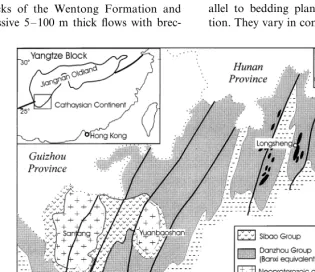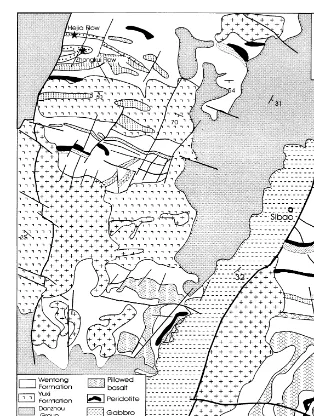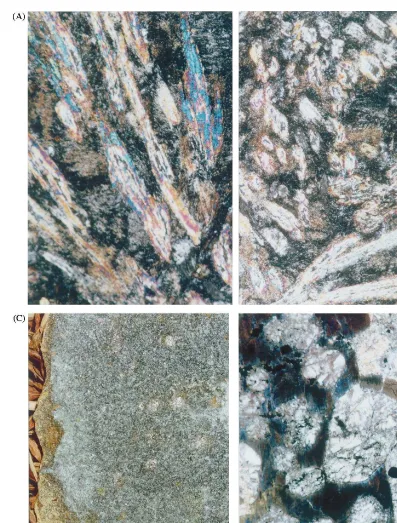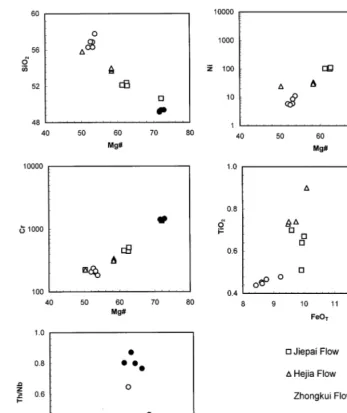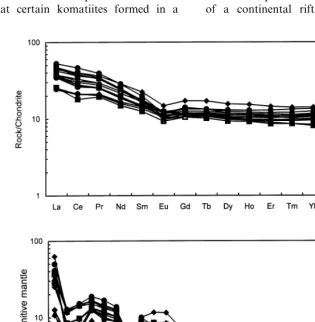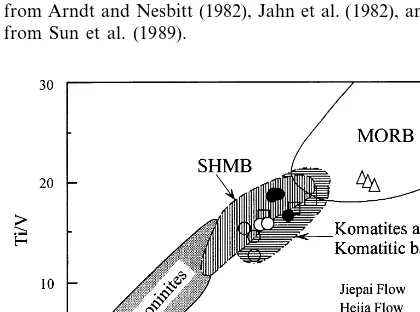Crustal-contaminated komatiitic basalts in Southern China:
products of a Proterozoic mantle plume beneath the
Yangtze Block
Mei-Fu Zhou *, Tai-Ping Zhao
1, John Malpas, Min Sun
Department of Earth Sciences,Uni6ersity of Hong Kong,Pokfulam Road, Hong Kong
Received 21 October 1999; accepted 24 March 2000
Abstract
Abundant mafic and ultramafic rocks including basalts, komatiitic basalts, and peridotites occur in the Proterozoic Sibao Group, northern Guangxi Province, China. Whereas the basalts are generally pillow lavas, the komatiitic basalts are typically spinifex-textured and, in a few cases, show pyroxene accumulation associated with NiCu(PGE)
sulfide deposits. The peridotites occur in the lower portions of differentiated sills, which contain gabbro and diorite in their upper parts. The sills are believed to be co-magmatic with the komatiitic basalts. The spinifex rocks of the Jiepai and Hejia Flows have MgO ranging from 8.9 to 14.3 wt%. The Zhongkui Flow is highly fractionated to form a spinifex zone with lower MgO (5.3 – 5.9 wt%) and a cumulate zone with higher MgO (17.3 – 17.9 wt%). Overall the rocks have TiO2=0.44 – 0.74 wt%. Relative to primitive mantle, they are enriched in Th and LREE, but exhibit
negative Ti-, Nb-, and P-anomalies. These features are consistent with their formation from a crustally-contaminated komatiitic magma. During this process of crustal contamination, the magmas assimilated sulfur from sediments, which caused sulfide-segregation resulting in the formation of NiCu(PGE) sulfide deposits. The occurrence of the
komatiitic basalts in the Sibao Group can be explained by the ascent of a mantle plume beneath a continental rift environment, and implies that the Yangtze Block may have had an Archean basement through which the Sibao komatiitic basalts erupted. © 2000 Elsevier Science B.V. All rights reserved.
Keywords:Crustal contamination; Komatiitic basalt; Proterozoic; Southern China
www.elsevier.com/locate/precamres
1. Introduction
Many Proterozoic terrains, including the Cape Smith Belt, Canada (Hynes and Francis, 1982) and the Baltic Shield (Park et al., 1984; Puchtel et al., 1997) contain komatiitic rocks that are inter-preted to represent products of high-Mg magmas derived by partial melting of the upper mantle. * Corresponding author. Tel.:+852-28578251; fax: +
852-25176912.
E-mail address:[email protected] (M.-F. Zhou).
1Present address: Henan Institute of Geology, Zhengzhou,
Henan, PR China.
These rocks are of considerable importance in studies of the composition of the Proterozoic up-per mantle (Jahn et al., 1980; Nisbet, 1982; Sun, 1987; Nisbet et al., 1993; Bickle et al., 1994) and aid in discerning the tectonic regimes of the host terrains.
Although the tectonics of southern China have been widely discussed since Hsu et al. (1988, 1990) proposed a model involving complex overthrust-ing to explain the Mesozoic collision between the Yangtze and Cathaysian Blocks, the presence of komatiitic basalts in northern Guangxi Province has not been discussed. Local geologists described spinifex-textured rocks in the Middle Proterozoic Sibao Group as komatiites (Mao et al., 1988; Yang, 1988), but this discovery has remained obscure. Chen and Mao (1995) described some ultramafic rocks as extrusive komatiites, but these appear to be olivine cumulate rocks which have resultant high Mg contents. Because their geo-chemistry is different from that of typical Archean komatiites, Li (1996) suggested that the spinifex rocks are not komatiite, but normal basalt. It is clear that the geochemical signature of these rocks needs to be re-examined and their significance interpreted.
This study provides a description of the distri-bution of the ultramafic and related rocks based on a mapping programme carried out by Dong (1988, 1990) and during our own field work in the past few years. This mapping has shown that many of the ultramafic and mafic rocks are, in fact, high-level sills that are interpreted to be co-magmatic with lavas. Representative samples have been analyzed for major oxides and trace elements and an attempt has been made to iden-tify the composition of the parental magma. Con-sequently, some constraints can now be placed on the tectonic setting of the magmatism and the Proterozoic geological evolution of the region.
2. Regional geology
The area of northern Guangxi Province forms the southern end of the Jiangnan Oldland, north of the Cathaysian continent (Huang, 1945; Chang, 1996) (Fig. 1). The Jiangnan Oldland
con-tains Precambrian rocks interpreted to represent basement to the Yangtze Block, and a cover sequence of Sinian and Devonian sedimentary strata of neritic and terrestrial facies, which ap-pear to deposit in a stable tectonic setting.
In northern Guangxi Province, the Sibao Group forms the basal Proterozoic sequence and is uncomformably overlain by the Late Protero-zoic Danzhou Group (Figs. 1 and 2). The Sibao Group includes the Wentong and Yuxi Forma-tions. The lower part of the Wentong Formation comprises very mature terrigenous sandstones containing 40 – 86 modal % quartz. The upper part contains turbidites displaying classic Bouma sequences, cut by a number of sills and plugs of ultramafic and mafic lithologies (Fig. 2). The Yuxi Formation is composed of intermediate to acidic lava flows, ignimbrites, tuffaceous sediments, and intercalated mudstones.
The exact thickness of the Sibao Group is difficult to measure because the rocks are strongly folded and faulted, but is probably between 3 and 5 km (Dong, 1988). The age of these supracrustal rocks is not precisely known. As expected, no fossils have been observed in the Sibao Group, but Li (1996) reported whole rock SmNd data for the mafic volcanic rocks yielding an age of 19009100 Ma, revising a 2200 Ma SmNd isochron obtained by Mao et al. (1990). The Sibao Group is intruded by the Sanfang and Yuanbaoshan peraluminous S-type granites (Fig. 1), which contain zircons dated by SHRIMP at ca. 825 Ma (Li, 1999).
(1988, 1990) have suggested an alternative model in which Cathaysia was thrust on to the Yangtze Block during the Triassic, with the Danzhou Group and its equivalents forming a tectonic melange.
3. Mafic and ultramafic rocks in the Sibao Group
Basalts and komatiitic basalts in the Wentong Formation of the Sibao Group, occur as lava flows, and peridotites and gabbros as layered, subvolcanic sills (Fig. 2). The basaltic lavas ex-hibit pillowed, spherulitic, and amygdaloidal structures, and thick flows display columnar joint-ing (e.g. near Jiepai). These volcanic rocks have compositions similar to andesitic basalts (Mao et al., 1988).
The komatiitic basalts are interbedded with sed-imentary rocks of the Wentong Formation and occur as massive 5 – 100 m thick flows with
brec-ciated and chilled margins. Actual thicknesses are difficult to estimate because of widespread polyphase folding. We studied three typical flows, i.e. the Jiepai, Hejia, and Zhongkui Flows (Fig. 2). All three flows exhibit clinopyroxene spinifex-texture in which elongated and skeletal clinopy-roxenes (now replaced by tremolite) occur in a quenched devitrified matrix (Fig. 3(A) and (B)). Both the Jiepai and Hejia Flows are spinifex-tex-tured throughout with well-developed chilled mar-gin, whereas the Zhongkui Flow displays a spinifex-textured upper part and a pyroxene cu-mulate lower parts. The pyroxene cucu-mulates con-tain euhedral clinopyroxene, minor olivine and intercumulate plagioclase, and variable amounts of magmatic sulfides (Fig. 3(C)). Sulfide minerals can be highly concentrated in some occurrences, as reported by Mao et al. (1988).
The sills are subvolcanic intrusives injected par-allel to bedding planes in the Wentong Forma-tion. They vary in composition from peridotitic to
Fig. 2. Geological map of the Sibao area showing the distribution of mafic/ultramafic extrusives and intrusives in the Sibao Group. Drawn on the basis of geological mapping by Dong (1988, 1990) and this study.
dioritic (Fig. 2), and thicker sills are conspicu-ously layered. These layered sills have a thin lower chilled margin overlain successively by (1) peri-dotite containing rounded olivine chadacrysts en-closed in large pyroxene oikocryts (Fig. 3(D)), (2) gabbro, and (3) diorite. This layering was formed by crystal settling of olivine, clinopyroxene and then plagioclase within these subvolcanic bodies, which are interpreted to be co-magmatic with the extrusive komatiitic basalts.
4. Geochemistry of the komatiitic basalts
Other trace elements, including REE, were ana-lyzed on a VG Elemental PlasmaQuad 3 induc-tively coupled plasma-mass spectrometer (ICP-MS) at the University of Hong Kong. We use the protocol of Jenner et al. (1990), with standard additions, pure elemental standards for external calibration, and BHVO-1 as a reference material. Accuracies of the XRF analyses are estimated as 92% for major elements present in concentra-tions greater than 0.5wt% and 95% for trace elements. The ICP-MS analyses yield accuracy better than 95%. Major oxides are normalized to 100% on a volatile-free basis and all data are listed in Table 1.
The spinifex rocks of the Jiepai and Hejia Flows have MgO ranging from 8.9 to 14.3 wt% (Table 1 and Fig. 4). The spinifex rocks of the Zhongkui Flow have lower MgO (5.3 – 5.9 wt%) than typical komatiitic basalts. This flow is highly fractionated to form a high-Mg cumulate zone in the bottom with MgO contents ranging from 17.3 to 17.9 wt%. Therefore, overall the rocks can be called komatiitic basalts.
SiO2 contents (49.1 – 57.8 wt%) are lower, but
FeOT contents (9.4 – 13.6 wt%) are higher than
typical boninites (\53 wt% SiO2 and 6 – 7 wt%
FeOT at 10 – 12 wt% MgO) (Crawford et al.,
1989). All samples are low in TiO2 (0.44 – 0.90
wt%), similar to low-Ti tholeiites (Kerrich et al., 1998), but higher than typical boninites (Craw-ford et al., 1989). The Mgc’s of all samples range from 53 to 81 and correlate positively with Ni and Cr (Fig. 4).
The komatiitic basalts have Al2O3/TiO2close to
20, except the Zhongkui spinifex samples which have higher ratios of ca. 33. CaO/Al2O3 ranges
from 0.54 to 0.79. Zr/Y ratios range between 3.61 and 12.2, higher than the chondritic ratio (ca. 2.5). The spinifex-textured samples in the Zhongkui Flow have the highest SiO2and also the
highest Th/Nb and La/Sm values (Fig. 4). Th/Nb correlates positively with La/Sm in samples from the Jiepai and Hejia Flows (Fig. 4).
All rocks have REEN patterns enriched in
LREE with flat HREE (Fig. 5(A)). The primitive mantle-normalized trace element plot (Fig. 5(B)) displays enrichment in large ion lithophile ele-ments normally concentrated in the continental
crust, especially Ba, Th, U, Pb, and Sr, and shows strong negative Ti-, Y-, Nb-, P-, and Ta-anoma-lies. The rocks also have low concentrations of Sc and V.
In a diagram of Ti versus Zr (Fig. 6), the Sibao volcanic rocks are scattered. However, samples from individual flows form noticeable trends. All samples have Ti contents similar to many other komatiitic basalts and Siliceous High-Magnesian Basalts (SHMB) of Sun et al. (1989). High-Si spinifex-textured rocks of the Zhongkui Flow and two samples from the Hejia Flow have Zr con-tents higher than SHMB, whereas all other sam-ples plot in the SHMB field (Fig. 6). They have lower Ti/Zr values than primary (un-contami-nated) komatiitic basalts (ca.100) and MORB (100 – 200). In Fig. 7, the Hejia Flow falls in the MORB field because of its low V and Sc contents. Again, all other samples plot in the SHMB field and have Ti/V and Ti/Sc ratios similar to komati-ites and komatiitic basalts from other locations. They are, however, distinct from boninitic rocks (Fig. 7).
5. Crustal contamination in the komatiitic basalts
The elements Al, Ti, REE, HFSE (Th, Nb, Ta, Zr, Hf), Y, Sc and V are considered the least mobile during hydrothermal alteration and green-schist facies metamorphism of mafic volcanic rocks (e.g. Ludden et al., 1982; Kerrich et al., 1998). Therefore, although the mineralogy of the komatiitic basalts indicates that they have been metamorphosed to sub-greenschist facies, REE, Zr, Y, Nb and Hf have coherent trends, likely reflecting characteristics of the primitive magma and processes of magmatic differentiation either before, during or after eruption.
The spinifex textured rocks in the Sibao Group have lower SiO2 contents but higher FeOT
geo-Table 1
Chemical compositions of komatiitic basalts from the Sibao Group, Northern Guangxi Province, China
Sample Jiepai flow Hejia flow
location
Textures Spinifex-texture
GX-4 GX-5 GX-14 GX-16 GX-17 GX-18
GX-3 GX-1
Sample no.
Major oxides(wt%)
52.4 52.1 50.7 52.1 55.8 53.7 53.9 54.0
SiO2
0.51 0.67
TiO2 0.70 0.64 0.90 0.74 0.73 0.74
11.9 14.4 15.0 15.0
14.1 15.0
Al2O3 14.4 14.8
11.0
10.7 11.0 11.1 11.2 10.8 10.5 10.6
Fe2O3 a
14.3 8.89 5.73 7.66
MgO 8.98 9.35 7.46 7.46
9.08 11.0 8.04 8.16
11.1 8.31
10.6 8.51
CaO
0.17
0.16 0.18 0.17 0.17 0.17 0.17 0.17
MnO
1.42 1.05 2.24 2.39
Na2O 1.20 1.20 2.60 2.34
0.66 0.38 0.70 1.20
0.27 1.16
0.74 1.26
K2O
0.06
0.07 0.05 0.07 0.12 0.08 0.07 0.08
P2O5
3.36 2.78 2.48 2.60 2.44 2.24
LOIb 2.83 3.18
Trace elements(ppm)
32 35 30
Sc 34 35 30 30 30
220 223 184 221 191 218 227 214
V
18.1 24.6 11.9 11.3 21.2 23.5 25.8
Rb
57 105 129 125
Sr 105 120 158 144
12.4 10.0 16.7 13.9
13.2 15.9
Y 11.7 14.4
3.57
4.08 2.94 4.27 9.00 5.91 6.08 6.05
Nb
1.06 0.65 1.01 0.99
Cs 0.83 0.73 1.58 1.44
5.92 6.32 6.01 10.9 9.22 9.21 8.76
La
11.5 13.6 25.7 20.1
Ce 13.3 13.5 21.2 19.2
1.87 1.95 3.52 2.83
2.04 2.84
Pr 2.01 2.67
7.94
7.81 7.06 7.49 13.6 10.9 10.9 10.3
Nd
1.93 2.09 3.46 2.72
Sm 2.22 2.20 2.75 2.58
0.54 0.61 0.86 0.68
0.65 0.72
0.63 0.68
Eu
2.42
2.36 2.15 2.16 3.51 2.76 2.75 2.58
Gd
0.38 0.40 0.64 0.50 0.50 0.47
Tb 0.44 0.45
2.37 2.49 3.96 3.02
2.87 3.19
2.80 3.00
Dy
0.64
0.63 0.52 0.54 0.87 0.66 0.69 0.66
Ho
1.43 1.49 2.40 1.82
Er 1.77 1.83 2.00 1.92
0.22 0.22 0.36 0.28
0.28 0.31
0.26 0.29
Tm
1.84
1.76 1.34 1.39 2.34 1.78 2.08 1.88
Yb
0.20 0.20 0.34 0.27 0.31 0.29
Lu 0.26 0.28
0.98 1.58 3.57 2.34
1.62 2.35
Hf 1.81 2.37
0.24
0.27 0.19 0.26 0.62 0.40 0.40 0.39
Ta
5.37 8.34 12.5 8.88 9.53 8.73
Pb 11.9 10.4
0.96 1.07 3.00 2.40
1.08 2.42
0.91 2.14
Th
0.36 0.53
Table 1 (Continued)
GX-1 GX-4 GX-5 GX-14 GX-16 GX-17 GX-18
Sample no.
72 61 50 58
63 58
cMgc 63 58
CaO/Al2O3 0.74 0.79 0.76 0.76 0.54 0.54 0.55 0.57
20.6 22.0 23.4 21.5 16.7 20.3 20.6 20.0
Al2O3/TiO2
4.37 12.2 9.79 11.3
8.96 9.48
GX-19 GX-21 GX-22 GX-23 GX-24 GX-25 GX-26 GX-27
Sample no.
Major oxides(wt%)
56.3 56.9 56.3 49.4
57.8 49.1
56.9 49.2 49.4
SiO2
0.44
0.45 0.47 0.45 0.48 0.52 0.52 0.51 0.52
TiO2
15.2 15.1 15.2 10.2
Al2O3 15.2 14.5 10.3 10.4 10.3
9.75 9.59 10.26 13.6
9.36 13.8
9.57 13.6 13.2
Fe2O3 a
5.50
5.48 5.32 5.37 5.89 17.7 17.5 17.3 17.9
MgO
9.42 8.90 8.35 6.96 6.99 7.03
CaO 8.66 9.23 6.96
0.17 0.17 0.17 0.19
0.16 0.19
MnO 0.16 0.19 0.19
2.75
2.27 2.17 1.97 1.42 0.58 0.66 0.76 0.65
Na2O
1.07 1.40 1.74 0.55 0.59 0.69
K2O 1.26 0.20 0.57
0.08 0.07 0.08 0.06
0.06 0.06
0.07 0.06 0.06
P2O5
LOIb 2.20 1.80 1.37 1.60 1.71 4.57 4.82 4.40 4.83
Trace elements(ppm)
Sc 30 30.4 31.4 29.8 29.3 31.3 30.7 31.3 31.2
175 180 185 165
177 164
V 181 167 176
182
204 207 236 213 1390 1420 1429 1470
Cr
5.91 5.40 8.63 2311
Ni 6.04 11.2 1942 1748 1616
4.61 8.10 8.30 1327
7.73 1260
18.3 21.7 38.0 23.7
5.39 26.3
Rb 23.4 30.6 27.5
102
104 97 104 109 25.2 29.0 34.9 30.5
Sr
12.2 12.3 16.3 15.2
Y 12.9 13.5 14.4 14.9 16.0
8.50 8.63 9.13 4.12
8.25 4.19
8.81 3.94 4.53
Nb
0.39
1.24 0.72 1.84 3.81 1.21 1.38 1.47 1.44
Cs
160
Ba 217 52 243 245 119 144 175 153
11.6 11.3 12.9 8.50
10.4 8.84
11.39 9.04 9.31
La
23.3
24.3 25.3 23.6 29.6 16.7 17.5 17.5 17.8
Ce
3.35 3.27 3.79 2.47
Pr 3.21 3.27 2.42 2.47 2.47
11.8 11.6 13.5 9.13
11.7 8.84
11.3 9.11 9.29
Nd
2.70
2.49 2.67 2.61 3.06 2.24 2.22 2.31 2.27
Sm
0.62
Eu 0.57 0.63 0.58 0.68 0.73 0.71 0.71 0.74
2.39 2.34 2.87 2.32
2.46 2.33
Gd 2.22 2.33 2.38
0.44
0.40 0.43 0.41 0.50 0.40 0.40 0.40 0.42
Tb
2.68
Dy 2.56 2.70 2.65 3.31 2.53 2.49 2.50 2.62
0.60 0.59 0.73 0.54 0.54 0.55 0.56
0.60
Table 1 (Continued)
Jiepai flow
Sample Hejia flow
location
Textures Spinifex-texture
GX-3 GX-4 GX-5 GX-14 GX-16
GX-1 GX-17
Sample no. GX-18
Er 1.62 1.77 1.74 1.70 2.15 1.56 1.61 1.56 1.62
0.29 0.27 0.27 0.34
Tm 0.25 0.24 0.24 0.24 0.25
1.94 1.81 1.76 2.24
1.63 1.59
Yb 1.60 1.58 1.67
0.25
Lu 0.29 0.27 0.26 0.32 0.24 0.24 0.24 0.25
2.61 2.49 2.37 2.33
Hf 2.32 1.56 1.60 1.52 1.63
0.58 0.59 0.59 0.62
0.58 0.27
Ta 0.29 0.27 0.30
13.2
Pb 14.1 9.3 15.0 9.9 172 201 132 146
5.33 3.11 2.78 4.24 3.31 3.35
Th 3.48 3.43 3.47
1.72 1.65 1.60 1.67 0.67
1.55 0.69
U 0.64 0.68
cMgc 53 54 52 53 53 72 72 72 73
0.64 0.62 0.59 0.55
CaO/Al2O3 0.57 0.68 0.68 0.67 0.67
33.0 32.7 33.9 31.9
33.5 19.7
Al2O3/TiO2 20.0 20.3 20.0
8.54
Zr/Y 7.20 7.85 7.37 5.28 3.85 3.93 3.61 3.86
0.65 0.37 0.32 0.46 0.80
Th/Nb 0.40 0.80 0.87 0.77
aFe
2O3as total iron. bLOI, loss on ignition.
cMgc=100×Mg2+/(Mg2++Fe2+), Fe2+ is calculated from total FeO. Major oxides were recalculated to 100% on a volatile-free basis.
chemistry also distinguish them from most other komatiitic basalts (Arndt et al., 1977; Hynes and Francis, 1982) which are high Mg, LREE-de-pleted lavas. Nor can the REE signatures of the spinifex-textured rocks in the Sibao Group be explained by fractionation of olivine and pyroxe-nes from a komatiitic magma depleted in LREE, as these minerals do not fractionate REE effi-ciently enough to generate the observed LREE-enriched patterns.
Komatiitic basalts from the Sibao Group have pronounced negative Nb and Ti anomalies with corresponding LREE enrichment, similar to the SHMB of the Yilgarn Craton, Australia (Sun et al., 1989) and the komatiitic basalts from the Vetreny Belt, Southern Baltic Shield (Puchtel et al., 1997). These are geochemical features consid-ered indicative of a komatiitic magma contami-nated by continental crustal material (Arndt and Jenner, 1986; Juteau et al., 1988; Sun et al., 1989; Puchtel et al., 1997; Kerrich et al., 1998).
Average subcontinental lithospheric mantle and continental crust are both depleted in Nb and Ta
relative to Th and La (McDonough, 1990; Jochum et al., 1991). Contamination of astheno-spheric melts occurs during their ascent through the lithosphere and/or crust, resulting in a marked increase in Ba, Th, Zr, U, and LREE, but little change in Ta, Nb, HREE, and Ti concentrations. This results in negative Ta, Nb, and Ti anomalies on mantle or chondrite-normalized trace element variation diagrams. The Sibao komatiitic basalts exhibit such negative Nb- and Ta-anomalies, but the rocks with the lowest Nb/Th and Nb/La also have the highest SiO2 and Zr contents. This can
Fig. 4. Compositional and elemental ratio plots of the komatiitic basalts from the Sibao Group. Mgc=100×Mg/(Mg+Fe2+); Fe2+ is calculated from total FeO.
formed layered sills. The thick lower peridotite zones indicate accumulation of olivine and repre-sent sheet sills like those in the Cape Smith Belt, Canada (Hoffman, 1990).
The occurrence of NiCu(PGE) sulfide accu-mulations in the pyroxenite cumulates of some komatiitic basalt flows from the Sibao Group can also be explained by a process of crustal assimila-tion. The parental high-Mg magmas were likely S-undersaturated (Keays, 1995). Melting of crustal
and Stone, 1996). A similar situation occurs at Kambalda, Australia, in response to incorpora-tion of sulfide-rich sediments during the flow of komatiitic lava over unconsolidated sediments (Huppert et al., 1984; Lesher et al., 1984; Lesher and Campbell, 1993).
6. Tectonic setting and implications for the geology of southern China
Archean komatiitic magmas are interpreted to have formed as part of ancient oceanic lithosphere (Desrochers et al., 1993) or primitive ocean is-lands (Hoffman, 1990). However, the Belingwe greenstone belt of Zimbabwe provides a well-ar-gued case that certain komatiites formed in a
continental extensional setting (Nisbet et al., 1977; Bickle et al., 1994; Hunter et al., 1998). Old detrital zircons in some Archean komatiites confirm crustal contamination (Compston et al., 1986).
The Early Proterozoic komatiitic basalts of both the Cape Smith Belt (Hoffman, 1990) and the Vetreny Belt of the Baltic Shield (Puchtel et al., 1997) formed in continental rifts, and the komatiitic basalts in the Sibao Group are here considered to have been erupted in a similar tectonic setting. A sub-continental mantle plume is a preferred source of very high temperature, high-Mg magmas (Nisbet et al., 1993).
The occurrence of the komatiitic basalts in the Sibao Group is consistent with the development of a continental rift in which high-Mg lavas
Fig. 6. Ti vs. Zr for the komatiitic basalts from the Sibao Group. Boninite field from Poidevin (1994), Komatiitic basalts from Arndt and Nesbitt (1982), Jahn et al. (1982), and SHMB from Sun et al. (1989).
later juxtaposed over the initial rift sequence (Scott et al., 1992), rifting in the Northern Guangxi region did not result in continental breakup and opening of a new ocean. The lack of any significant felsic magmatism between 1.8 and 2.4 Ga in this region also implies that no large-scale arc system formed. In northern Guangxi Province, uplift of the crust above the mantle plume and subsequent volcanism explains why the Sibao Group is thinner than present day rift-related successions. Analogous suc-cessions are found associated with flood basalts related to the Trindade plume in Western Brazil (Gibson et al., 1997) and the Tertiary plume-related volcanic rocks in Western Greenland (Lightfoot et al., 1997).
The extent of the Proterozoic rift environment is not clear. The Lengjiaxi Group, a flysch sequence in NW Hunan Province, is considered the equivalent of the Sibao Group. Its lower part is represented by a meta-volcanic sequence more than 2000 m thick, including mafic lavas and tuffs. Spinifex-textured komatiites have also been reported (Xiao, 1987). It is possible that this belt in NW Hunan Province represents a separate, individual rift that formed simultaneously with that in Northern Guangxi Province. The presence of a plume under the craton would have caused uplift and formed a series of grabens in which sediments accumulated. One or more of them could be considered aulocogens.
This model for the formation of the komatiitic basalts requires that the Sibao Group was essen-tially deposited on continental crust. The oldest rocks known in the Yangtze Block are the Kangding and Kongling gneisses of 2400 – 2950 Ma (Wang et al., 1985). The polymictic conglomerate in the lower part of the Fanjingshang Group in Guizhou Province, an equivalent of the Sibao Group, contains clasts of various metamorphic rocks and granites, apparently derived from the underlying basement. SmNd isotopes from the granodiorite of the Sibao Group suggest that this rock was a product of anatexis of older continental crust. The model age calculated is 2513 Ma (Mao et al., 1988). Older UPb ages of 2860 – 3289 Ma have been obtained from zircons in the Sanfang Granite, which intrudes the Sibao Group (Huang, 1998). These zircons are interpreted as refractory xeno-crysts trapped in granitic magmas derived from the Fig. 7. Ti/V vs. Ti/Sc for the komatiitic basalts from the Sibao
Group. SHMB from Sun et al. (1989), MORB and komatiitic basalt from Wolde et al. (1996), boninites from Hickey and Frey (1982).
erupted during deposition of terrigenous sediments. The early stages of this continental rifting are marked by the deposition of conglomerates, quartzites, and arkoses in the lower part of the Sibao Group. Subsequently, extensive eruption of high-Mg lavas was associated with the emplace-ment of mafic/ultramafic layered intrusions and followed by further rapid sedimentation.
old granulitic crust. All of this is evidence of an old continental crust underlying the Sibao Group, although no outcrops of this basement are exposed.
7. Conclusions
The komatiitic basalts of the Sibao Group ex-hibit clinopyroxene spinifex texture and REE pat-terns enriched in LREE. They are depleted in Ti, Nb, and P and enriched in Th and Si. These features suggest that they represent the quench crystalliza-tion of a high-Mg magma contaminated by assim-ilation of crustal sediments, which erupted in a continental rifting environment. The study further indicates that there was an old continental crust beneath the Sibao Group at the time of its forma-tion and that the magmatic event resulted in a substantial addition of new juvenile mantle mate-rial to the Yangtze continent. Crustal contamina-tion of this high-Mg magma locally resulted in S-saturation and we suggest that the area has significant potential for the discovery of economic NiCu(PGE) sulfide deposits.
Acknowledgements
This study was fully supported by a grant from the Research Grant Council of the Hong Kong Special Administrative Region, China (HKU7120/ 97P). Three field seasons investigating the Sibao Group were assisted by senior geologists Dong Baolin, Li Guotao, and Liang Guobao, all at the Geological Survey of Guangxi Province, China. We thank Yang Lizhen for informative discussion and Dr Li Jianwei for assistance with the preparation of this manuscript. We appreciate constructive comments made by Professor C.M. Lesher and an anonymous reviewer that helped to improve an earlier version.
References
Arndt, N.T., Nesbitt, R.W., 1982. Geochemistry of the Munro Township basalts. In: Arndt, N.T., Nisbet, E.G. (Eds.), Komatiites. Allen & Unwin, London, pp. 309 – 329.
Arndt, N.T., Jenner, G.A., 1986. Crustally-contaminated ko-matiites and basalts from Kambalda, Western Australia. Chem. Geol. 56, 229 – 255.
Arndt, N.T., Naldrett, A.J., Pyke, D.R., 1977. Komatiitic and iron-rich tholeiitic lavas of Munro Township, Northeast Ontario. J. Petrol. 18, 319 – 369.
Bickle, M.J., Nisbet, E.G., Martin, A., 1994. Archean green-stone belts are not oceanic crust. J. Geol. 102, 121 – 138. Chang, E.Z., 1996. Collisional orogen between North and
South China and its eastern extension in the Korean Penisula. J. SE Asian Earth Sci. 13, 267 – 277.
Chen, T., Mao, J., 1995. Metallogenic Series of Ore Deposits and Metallogenic Evolution Through Geological History in Northern Guangxi (in Chinese). Science and Technology Press of Guangxi, Guangxi, China, p. 433.
Chen, J.F., Foland, K.A., Xing, F.M., Xu, X., Zhou, T.X., 1991. Magmatism along the southeast margin of the Yangtze block: Precambrian collision of the Yangtze and Cathaysian Blocks of China. Geology 19, 815 – 818. Compston, W., Williams, I.S., Campbell, I.H., Gresham, J.J.,
1986. Zircon xenocrystals from the Kambalda volcanics: age constraints and direct evidence for older continental crust below the Kambalda-Norseman Greenstones. Earth Planet. Sci. lett. 76, 299 – 311.
Crawford, A.J., Falloon, T.J., Green, D.H., 1989. Classifica-tion, petrogenesis and tectonic setting of boninites. In: Crawford, A.J. (Ed.), Boninites and Related Rocks. Unwin Hyman, London, pp. 1 – 49.
Desrochers, J.P., Hubert, C., Ludden, J.N., Pilote, P., 1993. Accretion of Archean oceanic plateau fragment in the Abitibi greenstone belt. Can. Geol. 21, 451 – 454. Dong, B.-L., 1988. A discussion on the several problems of the
Precambrian tectonics in Northern Guangxi (in Chinese). Geol. Jiangxi 2, 176 – 181.
Dong, B.-L., 1990. The Sibao Group of Guangxi Province and its metallogeny (in Chinese). Guangxi Reg. Geol. 3, 53 – 58. Gibson, S.A., Thompson, R.N., Weska, R.K., Dickin, A.P., Leonardos, O.H., 1997. Late cretaceous rifting-related up-welling and melting of the Trindade Starting mantle plume head beneath Western Brazil. Contrib. Miner. Petrol. 126, 303 – 314.
Guo, L.Z., Shi, Y.S., Ma, R.S., Lu, H.F., Ye, S.F., 1985. Plate movement and crustal evolution of the Jiangnan Protero-zoic mobile belt, SE China. Earth Sci. J. Geol. Soc. Jpn. 2, 156 – 166.
Hickey, R.L., Frey, F.A., 1982. Geochemical characteristics of boninite series volcanics: implications for their sources. Geochim. Cosmochim. Acta 46, 2099 – 2115.
Hoffman P.F., 1990. On accretion of granite – greenstone ter-ranes. In: Robert, F. (Ed.), Greenstone Gold and Crustal Evolution, Val D’Or, Canada, Geological Association of Canada Mineral Deposits Division, Ottawa, pp. 32 – 45. Hsu, K.L., Sun, S., Li, J.L., Chen, H.H., Pen, H.P., Sengor,
A.M.C., 1988. Mesozoic overthrust tectonics in South China. Geology 16, 418 – 421.
Huang, T.K., 1945. On the major tectonic forms of China. Geol. Mem. Ser. A 20, 165.
Huang, X., 1998. Mid – Late Proterozoic (pre-Sinian) crust. In: Ma, X., Bai, J. (Eds.), Precambrian Crustal Evolution of China. Geolical Publishing House, Beijing, pp. 214 – 222. Hunter, M.A., Bickle, M.J., Nisbet, E.G., Martin, A.,
Chap-man, H.J., 1998. Continental extensional setting for the archean Belingwe greenstone belt. Zimb. Geol. 26, 883 – 886. Huppert, H.E., Sparks, R.S.J., Turner, J.S., Arndt, N.T., 1984. Emplacement and cooling of komatiite lava. Nature 309, 19 – 22.
Hynes, A., Francis, D., 1982. Komatiitic basalts of the Cape Smith Fold Belt, New Quebec, Canada. In: Arndt, N.T., Nisbet, E.G. (Eds.), Komatiites. Allen & Unwin, London, pp. 159 – 170.
Jahn, B.-M., Gruau, G., Glikson, A.Y., 1982. Komatiites of the Onverwacht Group, S. Africa: REE geochemistry, Sm/Nd age and mantle evolution. Contrib. Miner. Petrol. 80, 25 – 40. Jahn, B.-M., Auvray, B., Blais, S., Capdevila, R., Cornichet, J., Vidal, F., Hameurt, J., 1980. Trace element geochemistry and petrogenesis of Finnish greenstone belts. J. Petrol. 21, 201 – 244.
Jenner, G.A., Longerich, H.P., Jackson, S.E., Fryer, B.J., 1990. ICP-MS — a powerful tool for high precision trace element analysis in earth sciences: evidence from analysis of selected USGS reference samples. Chem. Geol. 83, 133 – 148. Jochum, K.P., Arndt, N.T., Hofmann, A.W., 1991. NbThLa
in komatiites and basalts: constraints on komatiite petrogen-esis and mantle evolution. Earth Planet. Sci. Lett. 107, 272 – 289.
Juteau, M., Pagel, M., Michard, A., Avobarede, F., 1988. Assimilation of continental crust by komatiites in the Precambrian basement of the Carswell structure (Saskatchewan, Canada). Contrib. Miner. Petrol. 99, 219 – 225.
Keays, R.R., 1995. The role of komatiitic and picritic magma-tism and S-saturation in the formation of the ore deposits. Lithos 34, 1 – 18.
Kerrich, R.W., Wyman, D., Fan, J., Bleeker, W., 1998. Boninite series: low-Ti tholeiite associations from the 2.7 Ga Abitibi greenstone belt. Earth Planet. Sci. Lett. 164, 303 – 316. Lesher, C.M., Campbell, I.H., 1993. Geochemical and fluid
dynamic modelling of compositional variations in Archean komatiite-hosted nickel sulfide ores in Western Australia. Econ. Geol. 88, 804 – 816.
Lesher, C.M., Groves, D.I., 1986. Controls on the formation of komatiite-associated nickelcopper sulfide deposits. In: Friedrich, G., Genkin, A.D., Naldrett, A.J., Ridge, J.D., Sillitoe, R.H., Vokes, F.M. (Eds.), Geology and Metal-logeny of Copper Deposits. Springer-Verlag, Berlin, pp. 43 – 62.
Lesher, C.M., Stone, W.E., 1996. Exploration geochemistry of komatiites. In: Wyman, D.A. (Ed.) Trace Element Geo-chemistry of Volcanic Rocks, Short Course Notes, vol. 12, Geological Association of Canada, Winnipeg, pp. 153 – 204. Lesher, C.M., Arndt, N.T., Groves, D.I., 1984. Genesis of komatiite-associated nickel sulfide deposits at Kambalda,
Western Australia: a distal volcanic model. In: Buchanan, D.L., Jones, M.J. (Eds.), Sulfide Deposits in Mafic and Ultramafic Rocks. Institute of Mining and Metallurgy, London, pp. 70 – 80.
Li, X.-H., 1996. SmNd isotopic system of the Sibao Group in the southern margin of the Yangtze Block and significance for the crustal evolution (in Chinese). Sci. Geol. Sin. 31, 218 – 227.
Li, X.-H., 1999. UPb zircon ages of granites from northern Guangxi and their tectonic significance (in Chinese). Geochimica 28, 1 – 9.
Lightfoot, P.C., Hawkesworth, C.J., Olshefsky, K., Green, T., Doherty, W., Keays, R.R., 1997. Geochemistry of Tertiary tholeiites and picrites from Queqertarssuq (Disko Island) and Nuussauq, West Greenland, with implications for the mineral potential of comagmatic intrusions. Contrib. Miner. Petrol. 128, 139 – 163.
Ludden, J., Gelinas, L., Trudel, P., 1982. Archaean metavol-canics from the Rouyn-Noranda district, Abitibi greenstone belt, Quebec, Part 2. Mobility of trace elements and petroge-netic constraints. Can. J. Earth Sci. 19, 2276 – 2287. Mao, J., Sun, S., Chen, T., 1988. Igenous Rock and Tin Deposits
in Guibei (in Chinese). Beijing Scientific and Technological Press, Beijing.
Mao, J., Zhang, Z., Dong, B., 1990. A new SmNd isotopic chronology of the Sibao Group in Southern margin of the Yangtze massif (in Chinese). Geol. Rev. 36, 264 – 268. McDonough, W.F., 1990. Constraints on the composition of the
continental lithospheric mantle. Earth Planet. Sci. Lett. 101, 1 – 18.
Nisbet, E.G., 1982. The tectonic setting and petrrogenesis of komatiites. In: Arndt, N.T., Nisbet, E.G. (Eds.), Komatiites. Allen & Unwin, London, pp. 501 – 518.
Nisbet, E.G., Bickle, M.J., Martin, A., 1977. The mafic and ultramafic lavas of the Belingwe greenstone belt, Rhodesia. J. Petrol. 18, 521 – 566.
Nisbet, E.G., Cheadle, M.J., Arndt, N.T., Bickle, M.J., 1993. Constraining the potential temperature of the Archean mantle: a review of the evidence from komatiites. Lithos 30, 291 – 307.
Park, A.F., Bowes, D.R., Halden, N.M., Koistinen, T.J., 1984. Tectonic evolution at an Early Proterzoic continental mar-gin: the Svecokarelides of eastern Finland. J. Geodyn. 1, 359 – 386.
Poidevin, J.-L., 1994. Boninite-like rocks from the Palaeoproterozoic greenstone belt of Bogoin, Central African Republic: geochemistry and petrogenesis. Precam. Res. 68, 97 – 113.
Puchtel, I.S., Haase, K.M., Hofmann, A.W., Chauvel, C., Kulikov, V.S., Garbe-Schonberg, C.D., Newchin, A.A., 1997. Petrology and geochemistry of crustally contaminated komatiitic basalts from the Vetreny Belt, Southeatern Baltic Shield: evidence for an early Proterozoic mantle plume beneath rifting Archean continental lithosphere. Geochim. Cosmochim. Acta 61, 1205 – 1222.
Sun, S.-S., 1987. Chemical composition of Archaean komatiites: implications for early history of the earth and mantle evolution. J. Volcan. Geotherm. Res. 32, 67 – 82. Sun, S.-S., McDonough, W.F., 1989. Chemical and isotopic
systematics of oceanic basalts: implications for mantle composition and processes. In: Saunders, A.D., Norry, M.J. (Eds.), Magmatism in the Ocean Basins, Geol. Soc. Spec. Publ. 42, 313 – 345.
Sun, S.-S., Nesbitt, R.W., McCulloch, M.T., 1989. Geochem-istry and petrogenesis of Archean and early Proterozoic siliceous high-magnesian basalts. In: Crawford, A.J. (Ed.), Boninites and Realted Rocks. Unwin Hyman, London, pp. 148 – 173.
Xing, F., Xu, X., Chen, J., Zhou, T., Foland, K.A., 1992. SmNd isotopic age of Proterozoic ophiolites in NE Jiangxi and its geological significance (in Chinese). Acta Petrol. Miner. 11, 120 – 124.
Wang, Y.Y., Xie, J.B., Chen, Y.L., Qin, S.Y., Zhu, S.C., 1985. Evolution of upper Precambrian volcanic – sedimentary se-quences in the western part of Jiangnan stratigraphic province, China. Precam. Res. 29, 109 – 119.
Wolde, B., Asres, Z., Desta, Z., Gonzalez, J., 1996. Neoprotero-zoic zirconium-depleted boninite and tholeiitic series rocks from Adola, Southern Ethiopia. Precam. Res. 80, 261 – 279. Xiao, X., 1987. Basic characteristics of spinifex-textured komati-ites in Hunan Province. J. South-Central College of Mineral. and Metall. 18, 498 – 493. (In Chinese)
Yang, L.Z., 1988. Spinifex textured komatiites in the Sibao Group, Guangxi Province (in Chinese). Guangxi Reg. Geol. 16, 9 – 12.
Zhou, G.Q., 1989. The discovery and significance of the northeastern Jiangxi province ophiolite, its metamorphic peridotite and associated high-temperature pressure meta-morphic rocks. J. SE Asian Earth Sci. 3, 237 – 247.
